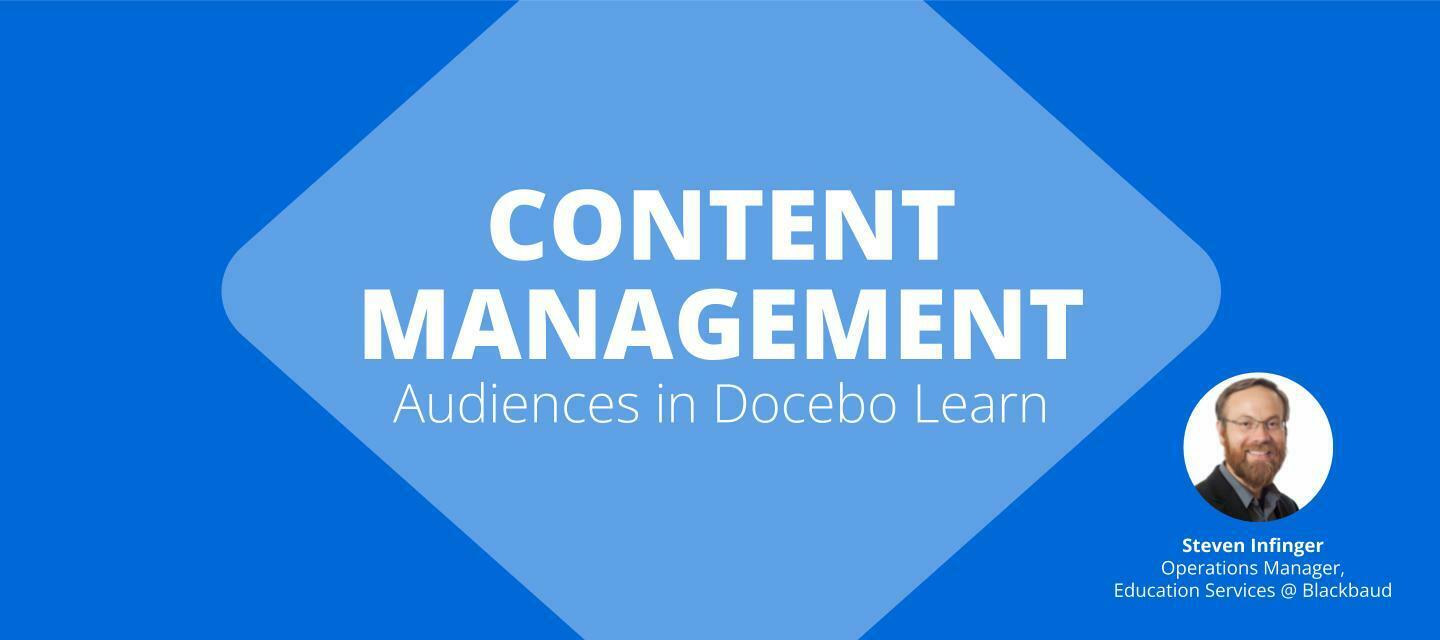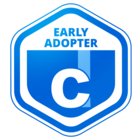Steven Infinger (Operations Manager, Education Services) from Blackbaud is here with a new guide on content management and consolidation. Blackbaud was a finalist at Docebo Inspire 2023 in the Best Customer Education Program category, and Steven is here to share their secrets to success!
Catch Steven tomorrow during DU Live, where he’ll talk more about content management and how crucial it is to customer education.
Blackbaud is the essential software provider for the people and organizations who change the world, and Blackbaud University is the educational arm that empowers these changemakers with knowledge. Our courseware goes beyond buttonology to take our customers on a learning journey that maximizes our client’s investment and increases their staff’s efficiency. The greatest impact to our organization is knowing that clients who consume our training are more likely to renew their product subscriptions; delighted and empowered clients are imperative to our business model.
In April 2021, Blackbaud began a 3-year project to consolidate seven LMS products into one unified LMS as each vendor contract came up for renewal. Our selection of Docebo and the past two years of successful collaboration across six departments has allowed us to increase efficiency, reduce software and maintenance costs, and most importantly, achieve a better learning experience for our 30K+ user base.
Guide Table of Contents
Our Objectives
- Consolidate multiple LMS products into one platform that supports internal (employee) and external (customer) learning.
- Implement engaging functionality that creates a community of learners.
- Reach as many learners as possible.
- Provide learning experiences that increase customer and employee retention.
- Simplify training for customers and employees by having one system for different types of learning throughout the company.
- Maximize shared resources within system administrators, including shared research and development across internal and external domains.
- Reduce our internal IT workload, while enhancing our cybersecurity and business continuity capabilities.
We are now 18 months into our transition, and Blackbaud’s new unified learning platform provides significant benefits. Choosing Docebo allowed us to reduce costs by streamlining processes and collapsing select domains, while minimizing duplication of effort internally to create a more effective and efficient team of administrators for our three use cases: Blackbaud University (for external customer training), DevelopU (for internal employee training), and Blackbaud Partner Academy (for Blackbaud partners training). We have achieved each of our objectives and are continuing to grow our use of Docebo LMS.
Essentials of Content Management
Key to the successful deployment of a learning experience is careful consideration of effective content management. These essentials are reflected in each step of our consolidation.
Audience Segmentation
User management is the first step of content management, as different audiences have different learning needs. Docebo Learn offered Extended Enterprise, a key audience segmentation tool for us as it allowed us to consolidate separate audiences into one LMS.
Examples:
- BlackbaudU: Customer training
- VILTs, eLearning, and exams grouped into catalogs and learning plans
- Using surveys to gather feedback to make UI/UX improvements so customers can find content easily.
- Entice customers through gamification and rewards
- 486 courses and 5,906 sessions in 2022
- 25.41K unique users from 8,738 orgs in 2022
- 116.36K VILT training hours
- DevelopU: Internal training
- Including annual compliance training for all internal employees and contingent workers
- Blackbaud Partner Academy: Corporate partner training
- Use of sub-branches and groups to provide access to the proper training.
- Certifications to ensure they are providing a service and knowledge that meets Blackbaud’s standards.
Asynchronous vs. Synchronous Learning
Online learning offers more flexible learning options than in-person classrooms. We use a blended approach of asynchronous and real-time virtual training to deliver the most robust learning experience possible. This includes but is not limited to:
- Sample database environments (sandboxes)
- VILT classrooms including audio and video troubleshooting
- Weekly sprints to help set priority levels and lift requirements
- Scheduling approximately 125 VILTs per week
- Assisting other departments with internal training
- Regular projects and process improvements to continue innovating
Content Discoverability
Learners need to be able to identify the content they need quickly. Sometimes this is self-guided using an option like Docebo’s global search. Oftentimes intentional UI/UX design is the trick to directing users by showing them exactly what to do next. Our design strategy splits our products up into different landing pages, and then further segments training by roles, outcomes, and functionality. These options give clients multiple pathways to find the right training to meet their needs.
Engaging Users
It’s not enough to simply put the training out there for users. Incentivization is vital to keeping users invested in their learning journey. Options like Gamification and Certifications add value for learners through rewards and recognition of skill development.
With these essentials in mind, we set forth with a comprehensive content consolidation plan.
Measurable Impact
Blackbaud University
- ROI stats = paragraph below
- Attach rate = 94% for 2022
- Consumption= 190,865 completions in 2022
- NPS = Q1 21 73%, Q1 22 77%, Q1 23 78%
Through customer surveys, BlackbaudU has determined that our training amplifies organization efficiency by saving customers 7.6 hours of work per week, allowing fundraisers to raise 9% more funds for their organizations, and retaining 17.5% more donors.
From Q1 2021 to Q1 2022 after our Docebo go-live, we saw a 6% increase in our Net Promoter Score. In Q1 of 2023, we saw our NPS increase another 1%. Without a robust LMS capable of handling our EXE use case, our business would not be able to provide these benefits which ultimately lead to customer delight and renewals. The LMS is a cornerstone to scaling our business.
The improvements in functionality have also led to higher productivity for our Operations team. For example, in our previous system, our 125 VILT sessions each week were added individually; In Docebo, they are bulk imported into the system, saving us 8+ hours of work each week.
From a company standpoint, consolidating multiple LMSs into a single system allowed us to better align with the flexibility of our workforce management plan, the innovation of our product development, and the stability, security, and accessibility of our digital-first initiative. The consolidation also provides continued savings over time which we can then translate into benefits for our learners.
These learners completed 5,906 sessions in 2022 for a total of 116,360 VILT training hours. In 2023, we have already seen our training consumption grow by more than 10%, and we expect this trend to continue through the rest of the year. This increase in training consumption is enabled by innovations in our LMS, such as global search, strategic course organization, and rewards program initiatives.
Our consolidation of content within 7 different LMS vendors into a single Docebo Learn LMS has built us a unified structure from which our business can thrive. Where we used to have to add 125+ VILT sessions per week manually, we are now able to automate and save significant work time. Our approach taught us that a robust LMS is imperative for scaling our business. In the future, we plan to continue innovating, reducing duplication of efforts, and delivering training that empowers our learners to change the world.
Docebo University Resources for Content Management
Segmenting by Audience
DU Live: How to Use Groups to Personalize User Experiences
Taking Learning Beyond Your Organization with Extended Enterprise
DU Live: How Customers Are Training New Audiences with Extended Enterprise
E-Learning
Creating and Managing Tests Using the Question Bank
DU Live: How to Develop Effective Assessments Using the Question Bank
Live Trainings (ILT)
Managing Live Training Courses
DU Live: How Customers Offer Successful Live Trainings with ILT Courses
Making Content Discoverable
Engaging Users
How Docebo Admins Are Driving Engagement with Gamification






